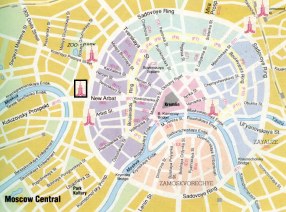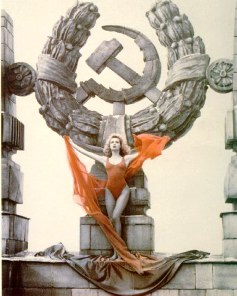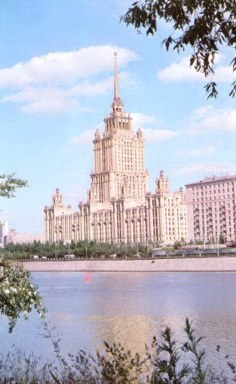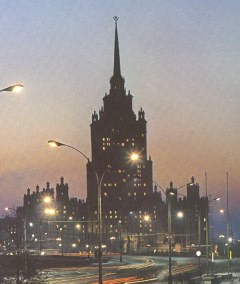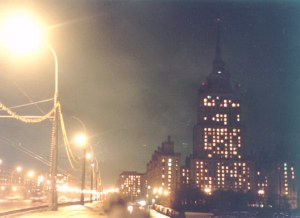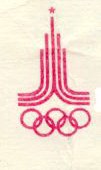 |
home | Dave's Russia Page
Ukraine Hotel
|
Click on any picture to enlarge
|
Ukraine Hotel 1950- 1955 - Kutuzovsky Prospect This hotel featured in "The Russia House" the film adaptation of John Le Carré's Glasnost-era spy thriller in which Sean Connery plays a British publisher of Soviet books. Sean Connery's character in the film stays in this hotel and from his room can be seen on of the huge concrete hammer and sickle sculptures that adorn the hotel (featured elsewhere on this page). There is also a scene that captures the front of the hotel, in which Sean Connery meets a female Russian publisher (played my Michelle Pfeiffer) outside the hotel. |
Sitting across the river on the opposite bank of the White House, the hotel was in a prime position (if not a little too close for comfort) to view the events of October 1993 when the army had to use force to end the siege of the Russian Parliament. The front facing rooms were evacuated as there were many stray bullets flying around. The 29-storey hotel occupies the main part of the building in the central tower that is 170 meters high. It was sited at a very advantageous position on one of the sharpest bends in the Mosocw river where a major arterial road stretches across (where Kutuzovsky boulevard meets Novy Arbat). |
|
It was perceived that this was one of the more prominent locations characteristic of the city. The side blocks of the building, 8-10 storeys high, were designated for living accommodation and contains 254 apartments. In front of the hotel is a square leading to wide granite steps that descend to the river. In 1974 a monument to Taras Shchevchenko (one of the greatest writers of the Ukraine) was erected on the square. The hotel itself is a massive complex where the emphasis is placed is on the central tower with its monumental entrance and crowing spire. To its left and right, the grand entrance is adorned with winged turrets. There are 1,032 rooms in the hotel with 1,627 beds. |
|
| Stylistically, the construction is a product of Stalinesque classicism, characteristic of the Vysotniye Zdaniyes, where the ordered arrangement of the facade is combined with massive sculptured decoration including elements of Soviet symbolism. In this case the classic wedding cake structure is crowned with a turret supporting a spire and five-pointed star. Around the turret and the top of the side blocks are large sculptures of vases with shafts of wheat symbolising the agricultural fertility of the Ukraine (formerly known as the bread basket of the Soviet Union). This creates a complex pattern in the building's silhouette. On the whole the building is well proportioned with its constituent elements arranged in a balanced composition. In the course of the design process the architect worked out a special system for proportioning the facade using a network of similar triangles. |
|
The interior of the hotel preserves a lot of the original decor including the furniture, light fittings and paneled doors, with the entrance hall finished off rather splendidly. In the center of the vast marble-lined hall is a large plafond, a kind of shade, portraying a people's festival in the Ukraine. The hotel possesses a unique fire system that is unlike any other Moscow Hotel. In the event of a fire a purely Russian invention is employed - a safety hose-cum-slide. Descending from one tier of the hotel to another on the outside walls an elastic "intestine" opens up allowing up to 10 people into its `womb' simultaneously to slide to safety. It is made of an artificial fibre, similar to nylon, produced in Russia called "Kapron". |
|
aFor over 40 years the city's grime, dirt and soot have eaten into the facade of the hotel. For the 850th anniversary of the Capital in 1997 it was decided to give the hotel a clean and to restore the grey stone to its original rose colour. A team of cleaners with specialist alpine training was invited to do the job. The ingrained dirt was removed using circular sanders and to complete the job a colourless compound was used on the walls to create protective film. |
